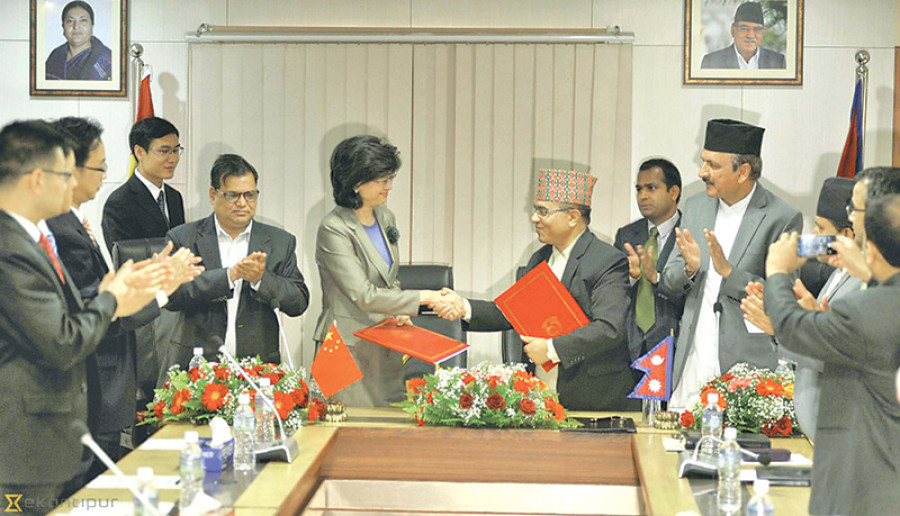Opinion
Trans-himalayan handshake
China and Nepal should move ahead with trans-Himalayan development, with or without India
Hu Shisheng
Ever since the establishment of formal Sino-Nepal diplomatic relations in 1955, China and Nepal have witnessed no perceptible ups and downs. This level of stability, unique in China’s relations with its neighbours, is the result of a number of reasons.
The two sides quickly settled nearly all outstanding disputes within a year of establishing diplomatic relations, and in 1956, China and Nepal inked The Treaty on Trade and Intercourse between Nepal and the Tibetan Region of China. In 1960, the two sides signed another very important treaty—Sino-Nepalese Treaty of Peace and Friendship. These two treaties went a long way in settling issues of the British legacy as well as Tibet related matters; they also included efforts of bilateral trade promotions.
Promoting mutual trust
By addressing areas of possible dispute, these measures created an environment of mutual trust to build up bilateral relations. This paved the way for stable development of bilateral relations in the years ahead.
China and Nepal have maintained relations and built a friendship based on the guiding principles of peaceful co-existence. There is a feeling of mutual respect and each country has abstained from involvement in the other’s internal affairs. Nepal has gone through a number of changes in regimes and governments since 1990, but there has been no evidence that China has had a hand in these changes. The Nepali government too has not allowed anti-China forces to create trouble for China through the use of Nepali territory since 1974.
In addition to this, China and Nepal have been sensitive to each other’s core national interests. China has been cautious in engaging with both Nepal and India, and understands that Nepal should not be made to choose sides between India and China. The Nepali government has also been very cooperative in prohibiting the Free Tibet Movement in Nepal and has made a great effort to stop the illegal emigration of Tibetans from China. For example, prior to 2005, 2,000 Tibetans annually fled from China into Nepal, and then made their way into third countries. However, in 2005, when former King Gyanendra took tough policies to prevent illegal emigration, the figure plummeted drastically (to 100 annually).
But stability and friendship is just one part of the Sino-Nepal bilateral relations; the fact that this partnership could generate benefits for the entire trans-Himalayan region should also not be overlooked.
The friendship between China and Nepal could address two threats that challenge regional peace and stability, thus contributing to peace in the trans-Himalayan region. The current India-China face-off in Doklam has the potential of escalating into a bloody conflict, endangering the entire trans-Himalayan region. Before such military conflicts arise, Nepal could play a key role in helping India and China come to a peaceful agreement. Nepal could use its special relations with both China and India and bridge the gap between these two nations.
The trans-Himalayan region has also been haunted by non-traditional threats. The situation in Darjeeling, Kashmir and Northeast India is still not stable. Additionally, in the past few decades, the Red Corridor that runs through Nepal and Tamil Nadu has even managed to reach Sri Lanka. Sino-Nepal cooperation and coordination could provide valuable information to the Indian government to tackle this issue. The Chinese governments played a role of constructive engagement by encouraging the Maoists to give up their arms and accept mainstream political culture, thus facilitating the peace process and political reconciliation in Nepal.
Untapped potential
Though China and Nepal could have made significant contributions to prosperity in the trans-Himalayan regions, regional disturbance and die-hard geostrategic mind-sets are obstacles to development. Geographically, the trans-Himalayan regions may be at the top of the world; but economically, Nepal, Bhutan, Bangladesh and Northern India fall among the least developed economies in line with the definitions of the United Nations and World Bank.
Nepal’s water resources, natural beauty and its unique geographic location between two giant markets could benefit the trans-Himalayan regions greatly if used properly.
Nepal’s water resources, which are second only to Brazil, could be a powerful locomotive for economic development in the trans-Himalayan region. However, the ground reality is that less than 2 percent of the proven hydropower potential has been tapped.
The Himalayan tourist industry alone could massively contribute to the national budget in Nepal and beyond. For example, tapping into the Chinese market with 1 billion followers of Buddhism caused substantial changes in the economic map of the region and resulted in tourism related services flourishing within Nepal and Northern India.
Transit facilities for goods, tourists and pilgrimages between China and India could present various wealth generation opportunities in the trans-Himalayan region. Two trans-Himalayan cargo transportations from China to Nepal were completed last year; such means of transport must be continued and scaled up. There is a need for solid physical connectivity.
The potentials mentioned above are still untapped or underdeveloped due to a number of reasons that range from political uncertainty (democratic dysfunction) to prolonged civil wars in Nepal’s southern region. These are issues that still need to be addressed in order to ensure future progress.
To each his own
Over the past years, Chinese and Nepali governments have approached India to develop regional resources through cooperation. For example, a joint construction of a China-Nepal-India economic corridor, building a regional power grid, tapping into Nepal’s water resources. has been touted. However, India has not been amenable to these initiatives, thus proving a roadblock to the construction of trans-Himalayan physical connectivity. I believe that China and Nepal should now moderate their policies and should not accord too much concern to New Delhi’s stance on things; this approach would perhaps allow the governments of China and Nepal to better meet trans-Himalayan development agendas.
China and Nepal have to work together to cement bilateral relations by building solid physical connectivity networks such as railways, pipelines and highways, ensuring reasonable and affordable production capacities, and developing tourist facilities. Should New Delhi be willing to cooperate, then India, China and Nepal can work towards the goal of developing the trans-Himalayan region together. If not, China and Nepal should continue with this initiative anyway.
The signing of the Belt Road Initiative Memorandum of Understanding between Kathmandu and Beijing this spring should be regarded as an opening of a brand-new chapter for China-Nepal relations.
Hu is Director of the Beijing-based Institute of South and Southeast Asian and Oceanic studies at Chinese Institute of Contemporary International Relations




 18.12°C Kathmandu
18.12°C Kathmandu











